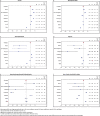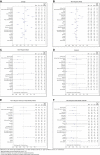Cancer Epidemiology in the Northeastern United States (2013-2017)
- PMID: 37583435
- PMCID: PMC10424700
- DOI: 10.1158/2767-9764.CRC-23-0152
Cancer Epidemiology in the Northeastern United States (2013-2017)
Abstract
We tested the hypotheses that adult cancer incidence and mortality in the Northeast region and in Northern New England (NNE) were different than the rest of the United States, and described other related cancer metrics and risk factor prevalence. Using national, publicly available cancer registry data, we compared cancer incidence and mortality in the Northeast region with the United States and NNE with the United States overall and by race/ethnicity, using age-standardized cancer incidence and rate ratios (RR). Compared with the United States, age-adjusted cancer incidence in adults of all races combined was higher in the Northeast (RR, 1.07; 95% confidence interval [CI] 1.07-1.08) and in NNE (RR 1.06; CI 1.05-1.07). However compared with the United States, mortality was lower in the Northeast (RR, 0.98; CI 0.98-0.98) but higher in NNE (RR, 1.05; CI 1.03-1.06). Mortality in NNE was higher than the United States for cancers of the brain (RR, 1.16; CI 1.07-1.26), uterus (RR, 1.32; CI 1.14-1.52), esophagus (RR, 1.36; CI 1.26-1.47), lung (RR, 1.12; CI 1.09-1.15), bladder (RR, 1.23; CI 1.14-1.33), and melanoma (RR, 1.13; CI 1.01-1.27). Significantly higher overall cancer incidence was seen in the Northeast than the United States in all race/ethnicity subgroups except Native American/Alaska Natives (RR, 0.68; CI 0.64-0.72). In conclusion, NNE has higher cancer incidence and mortality than the United States, a pattern that contrasts with the Northeast region, which has lower cancer mortality overall than the United States despite higher incidence.
Significance: These findings highlight the need to identify the causes of higher cancer incidence in the Northeast and the excess cancer mortality in NNE.
© 2023 The Authors; Published by the American Association for Cancer Research.
Figures





References
-
- Hutcheson TD, Greiner KA, Ellerbeck EF, Jeffries SK, Mussulman LM, Casey GN. Understanding smoking cessation in rural communities. J Rural Health 2008;24:116–24. - PubMed
-
- American Lung Association. State of lung cancer; 2022. Available from: https://www.lung.org/research/state-of-lung-cancer.
Publication types
MeSH terms
Grants and funding
LinkOut - more resources
Full Text Sources
Medical

